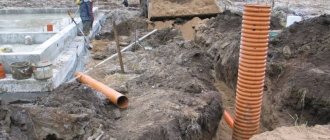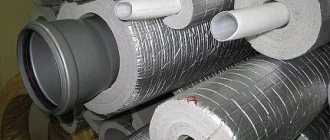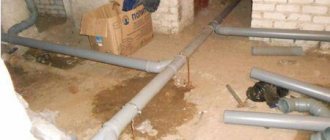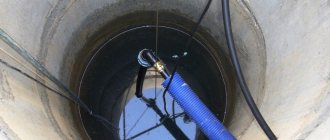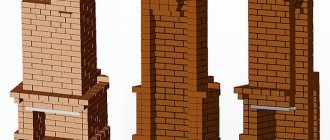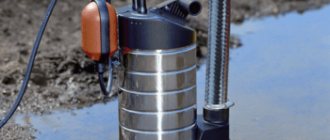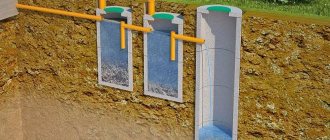The cast iron tee is one of the main elements of the sewer system.
It is an adapter that connects three pipes; by the way, one of them has a smaller diameter than the others.
This device is installed in places where the pipeline acquires several directions.
Many people wonder whether it is possible to replace a cast iron sewer tee? Practice shows that this can be done, but it is quite difficult with your own hands. Firstly, the technical process itself is quite complicated, and secondly, this type of repair of sewer pipes will require expensive tools. Well, in general, it is quite possible to replace this part of the system, because it is not cast together with the pipe.
This is what a cast iron tee looks like
Replacing a tee using an angle grinder
Dismantling cast iron sewer
Replacing an old pipeline is not an easy task, especially when it comes to cast iron. The method of connecting the pipes plays a decisive role in the labor intensity of the process. The set of tools that will be used also depends on this. So, in order to carry out a more or less accurate repair of the sewer system, or more precisely, its complete replacement, you will need:
- grinder with cutting and grinding discs included;
- blowtorch;
- hammer and screwdrivers of various lengths, thicknesses, crosspiece;
- pipe wrench and chisel.
To completely dismantle a cast iron sewer, you will also need a hammer drill, a knife, a steel wedge, a chisel, a pipe cutter, and a crowbar. Do not forget that the first step is to determine how to connect the elements of the sewer system.
Hammer and pipe cutter
Where to start installation work
Pipes made of cast iron deteriorate over time. It all starts with corrosion, then the pipes become cracked and overgrown with internal deposits, thereby reducing the space for draining household waste. Old sewer lines can no longer fully perform their functions.
In order to spend the time most effectively on replacing the sewer system, it is necessary to adhere to a certain algorithm and sequence of actions. Each stage is a very important link in the entire chain of events, and a violation committed during the performance of any type of work can fatally affect the functioning of the entire sewer communications system. First of all, it is necessary to dismantle communications, the condition of which, as a rule, leaves much to be desired. After all, they bear the main burden of transporting waste from the house to the tee and then to the riser.
Sequence of work:
- Compiling a list of necessary materials and tools that will be useful in the process of work, with their subsequent purchase;
- Drawing up that part of the sewer communications plan that includes the placement of a bathtub, sink, tee, shower and other plumbing fixtures;
- Dismantling an unusable sewer system;
- Carrying out work on installing new pipes, connecting all necessary plumbing devices to the sewerage system;
- Sealing seams and joints;
- Finishing finishing to give a beautiful appearance.
What to do if cast iron pipes are connected with sulfur
You can determine with what substance the pipeline was built using a blowtorch. If, when it is brought to the junction, the substance begins to melt, then it is definitely sulfur. The destruction process itself is divided into several stages:
- The pipe that is located farthest from the riser is the first to break. This is done with a hammer and continues until a crosspiece is found that needs to be loosened.
- At this time, you need to connect a blowtorch or gas heating pad. Under the influence of high temperatures, sulfur melts, and accordingly, it is possible to loosen the pipe. Before carrying out this procedure, you need to wear gloves to avoid burning your hands.
- After the sulfur has been removed, you can try to remove the cross from the riser.
This is what a blowtorch looks like
Caulking
This method has been used for a long time. It is used when installing cast iron pipelines. In this case, rubber seals are not used. The joints of communication sections are sealed using tow (winding made of flax). Cement mortar is used for strengthening. This method is used when the leak between the walls of cast iron and plastic pipes is 3-5 mm. Instructions for installing communications using the caulking method:
- Plumbing paste is applied to the plastic pipe, and tow is wound on top. The caulking depth is 2/3 of the socket length.
- The product is inserted into the cast iron pipeline until it stops.
- Compact the tow using a narrow spatula and a screwdriver.
- The remaining 1/3 of the socket is filled with polymer cement mortar. At home, it is prepared from cement, water and PVA glue.
The advantage of this method is a high degree of reliability. If the rubber adapter is used for 8-10 years, then thanks to the caulking method the pipeline joint will last much longer. It also has disadvantages. So, they note the need to wait 1-2 days until the cement mortar hardens. During this period the pipeline cannot be used. This will lead to deformation of the seam joint, which in the future will cause destruction of the polymer-cement layer and the appearance of a leak.
Description of the procedure for removing a cast iron sewer tee
A shaped piece of piping called a tee is located at the very bottom of the main riser. There are several ways to extract it. And it’s better to involve a professional in this. All cast iron tees for sewerage can be dismantled in three ways:
Breaking apart a cast iron tee with a screwdriver
- using a screwdriver and milk;
- by heating;
- using a grinder.
In the first case, you need to follow a certain order. First, you gently tap the tee. A gap should form between the pipe and the cross, into which a screwdriver can then be inserted and the tee removed.
Screwdriver and hammer
The second method is faster, but is accompanied by the release of an unpleasant odor. Most often, a gas heating pad or blowtorch is used when it is necessary to disassemble a connection with small diameter pipes. You can do this yourself, but if you don’t have experience, it’s better to hire a gas welder.
Gas welder services
The last method is to use an angle grinder. With its help, you need to cut off some parts of the tee and leave a small piece of pipe. After the remains of the product are cut, the socket is closed with a plug. The cut part of the cross is knocked out with a hammer. Finally, the treatment area is cleared of cast iron residues. It is worth noting that it is the last method of disassembling the tee that is the most practical and reliable, and does not require much time.
If after dismantling there is burning sulfur left on the crosspiece, then it must be lowered into a bucket of cold water, preferably made of iron. After the socket has cooled, you can begin installing a new riser made of plastic.
Installation of a plastic tee
Possible problems and solutions
errors in calculations. The assembler forgets to add to the length of the pipe blank the length of the section that will be inside the fitting (or adapter), and this is up to 15-20 mm per side; low quality of permanent (welded) connections. There are defects in the seams through which water leaks out. Eliminated by forming a new seam on top. In some cases it is necessary to completely digest the pipe
It is important to understand that even a small leak will eventually turn into a larger one; Water drips/oozes from threaded connections. It might need a little tightening. If the defect cannot be eliminated, you will have to disassemble the assembly and carefully inspect the condition of the threads - if the damage is severe, the element will have to be completely replaced
If everything is in order. then you need to wind more flax, apply another layer of sealant and try to properly tighten the connection again; improper soldering of polypropylene. As a result, the pipe connections are not very strong and can break when pressure is applied. During operation, you should follow the recommendations of the manufacturers of the soldering iron and the plastic products themselves. This applies to both the depth of edge penetration and the temperature of the device; choosing unreliable plumbing fixtures. Buying cheap devices on the market can lead to difficulties: constant breakdowns, broken fittings and flooding, and incorrect operation. It is recommended to use products from trusted Russian, Belarusian or European manufacturers; ignoring the requirement for the slope of the sewer line. Craftsmen do not maintain the required parameter (3 cm/m for a pipe diameter of 50 mm), this leads to difficulties in moving wastewater. To eliminate it, it is easier to redo the connecting point with the riser, otherwise the apartment owner will constantly encounter blockages; the features of the pipe materials used are not taken into account - linear expansion, different behavior under temperature changes, reaction to water hammer; Mistakes made when installing the system are often due to the lack of experience of the apartment owner. There must be ball valves on each riser - for shutting off the water, points for connecting meters. It is important to check the system before it is closed
If the defect cannot be eliminated, you will have to disassemble the assembly and carefully examine the condition of the threads - if the damage is severe, the element will have to be replaced completely. If everything is in order. then you need to wind more flax, apply another layer of sealant and try to properly tighten the connection again; improper soldering of polypropylene. As a result, the pipe connections are not very strong and can break when pressure is applied. During operation, you should follow the recommendations of the manufacturers of the soldering iron and the plastic products themselves. This applies to both the depth of edge penetration and the temperature of the device; choosing unreliable plumbing fixtures. Buying cheap devices on the market can lead to difficulties: constant breakdowns, broken fittings and flooding, and incorrect operation. It is recommended to use products from trusted Russian, Belarusian or European manufacturers; ignoring the requirement for the slope of the sewer line. Craftsmen do not maintain the required parameter (3 cm/m for a pipe diameter of 50 mm), this leads to difficulties in moving wastewater. To eliminate it, it is easier to redo the connecting point with the riser, otherwise the apartment owner will constantly encounter blockages; the features of the pipe materials used are not taken into account - linear expansion, different behavior under temperature changes, reaction to water hammer; Mistakes made when installing the system are often due to the lack of experience of the apartment owner. Ball valves must be present on each riser - to shut off the water, points for connecting meters
It is important to check the system before it is closed
Price issue
Replacing a sewer tee that will meet the requirements of GOST is a service that is in demand in the Russian Federation, and accordingly, it has its price. It is difficult to answer the question of price with utmost precision, because it depends on many factors. We are talking about the material used to make the new adapter that is planned to be installed. Just so you know, a propylene tee costs several times less.
The price of the service reflects:
- tee location;
- its diameter;
- current condition of pipes, etc.
The cost of the service is approximately 4000 rubles
Today, the cost of replacing a riser sewer pipe with a tee with a diameter of 110 mm is approximately 4 thousand rubles. Moreover, the price is not fixed and may vary depending on conditions.
Replacing an old vertical sewer pipe
One of the unpleasant events that can happen in a house is a burst drain. To prevent this from happening, it is necessary to replace the sewer riser with a more reliable material, for example, polyvinyl chloride pipes. You can do the work yourself or use the services of specialists.
At whose expense
Since the sewer riser is common property, its repair or partial replacement is carried out at the expense of the apartment owners. If tenants live under a social tenancy agreement, then the owner of the property is the state. In this case, the costs are compensated by the municipal budget.
The planned replacement of a sewer riser in an apartment building can be financed from funds allocated by residents for major repairs of the house.
The owner of the apartment, as well as the tenant, independently pays for materials and work to replace part of the riser in his apartment if he decides to change working communications at his own request. Such a replacement can be made, for example, during a major renovation of an apartment or during redevelopment.
Note! Payment for the work and costs of materials is made by the owner of the property. However, in the case of common property, this occurs through monthly payments for housing maintenance.
What is needed to replace a riser in an apartment with your own hands?
In houses built since the 50s of the 20th century, the toilet, bathroom and kitchen are located nearby. The first sewer unit is located under the sink, with a pipe coming from it. It passes through the bathroom, and in the toilet it crashes into a common riser.
Water containing waste goes into it. The pipes in the rooms are laid at a slight slope, so it moves by gravity. The pressure in the sewer system is not artificially increased. To prevent waste from stagnating in the pipes, when replacing parts of the sewer system, the degree of their slope should be controlled.
Providing sound insulation
Additionally, you can take measures to soundproof the sewer riser; they will be useful both in a private house and in an apartment.
Noise in the sewer can occur for a number of reasons, namely:
- When wastewater hits the walls of the pipeline;
- Penetration of foreign air into the system;
- Contact of pipes with walls or ceilings.
Soundproofing work will help eliminate noise-related inconveniences. This can be done in different ways:
- Installation of risers from special pipes. Of course, this measure is mainly used in the process of replacing an existing sewer system or laying a new one. Such products are distinguished by increased wall thickness and high density of the manufacturing material;
- Use of soundproofing materials. Most often, roll insulation or foamed polyethylene is used for this;
- The use of a special insulating “shell”. It is a finished product that is mounted on a laid pipe;
- Installation of the box and lining it from the inside with mineral wool.
Please note that some people use polyurethane foam for sound insulation; this is fundamentally wrong, since this material is not capable of absorbing sound.
Sound insulation work using roll materials includes the following actions:
- It is necessary to check the tightness of the joints, clean and degrease the surface of the riser;
- Apply vibration-damping material and roll it on top with a regular paint roller;
- Wrap the pipe with rolled sound insulation, securing it with flexible clamps (craftsmen often call them ties).
Installation of a soundproofing plasterboard box is carried out as follows:
- The pipes are carefully checked for leaks, because if a leak occurs, the entire structure will have to be disassembled;
- Wrapped with rolled soundproofing material;
- Markings are made for the future box. Please note that its walls should be 50-60 mm away from the surface of the pipe;
- A frame made of a metal profile is installed, with horizontal jumpers attached every 400-500 mm;
- We begin to install drywall, it is better to give preference to moisture-resistant. After one side is assembled, we lay mineral wool and sew up the remaining part.
Stages of work
We remind you that you cannot change the main drain manifold yourself. This is enshrined in law. In the event of emergency situations caused by excessive initiative, the culprit will have to answer.
For reference, the sequence of operations looks like:
- Notification of the management company and duty services. Application form, registration. Presence during external inspection of the structure. Participation in drawing up an external inspection report.
- Agreeing on the timing of repairs (in planned cases). Monitoring notifications to residents about ongoing repairs. If you wish, you can independently walk around all the apartments located along the removed collector. Preparing the premises for production work:
- cleaning of all household items;
- covering the toilet or other plumbing fixtures with protective material;
- providing specialists with a bucket and rags.
- Presence during production operations (without unnecessary interference). This is necessary to improve employee discipline. In addition, due to unforeseen circumstances, various problems may arise. For example: how to replace a tee in a riser. Help in this matter from the homeowner is the prompt purchase of the necessary parts and materials.
- Acceptance of new design. Signing the “Certificate of Completion of Work”.
Next, you should notify your neighbors about the completion of the repairs and begin cleaning the premises.
Who is obliged to change the riser
The communications of the apartment building, which are used by all residents (or part, for example, the entrance), belong to the common property of the house. Government Decree No. 354 of 05/06/2011 contains a list of sewerage elements that are the common property of residents. This list includes sewer risers with corners, crosses, and sockets up to the first connecting point. All the pipes that follow are the property of the people living in the apartment.
There are a number of other documents regulating the maintenance of household property that is in common ownership:
- Government Decree No. 491 of 08.08.2006;
- Methodological manual dated 04/02/2004;
- Decree of the State Construction Committee of September 27, 2003
According to these documents, responsibilities for repairing common property are assigned to companies managing residential buildings. The owners transfer to her the right to dispose of common property. No distinction is made between types of housing ownership: state, municipal, and privatized houses have equal rights in this regard.

